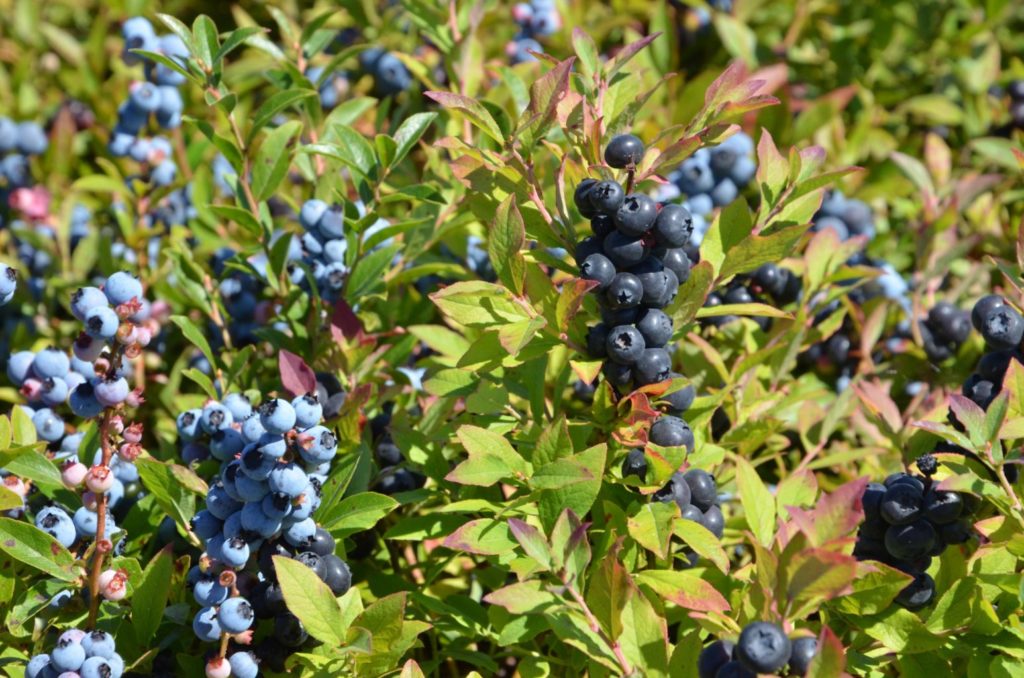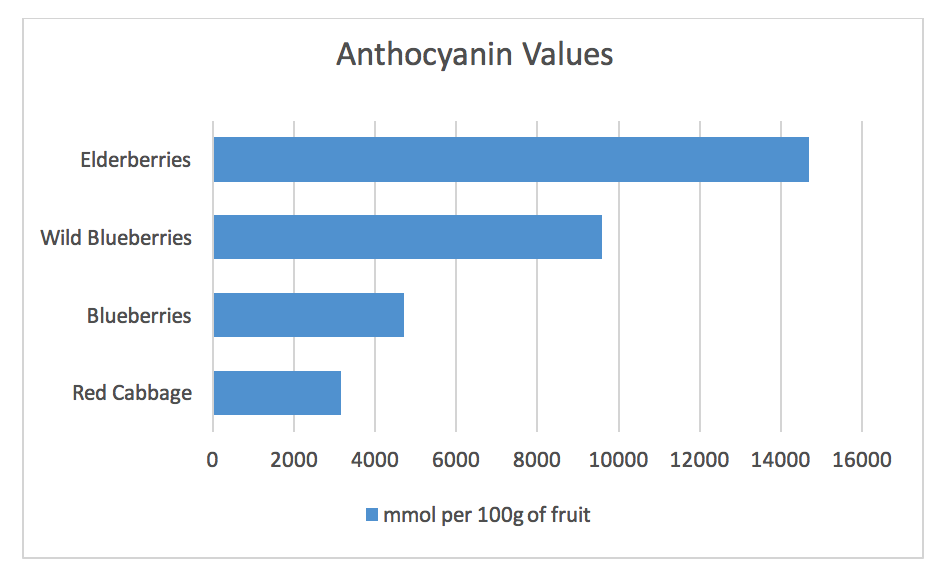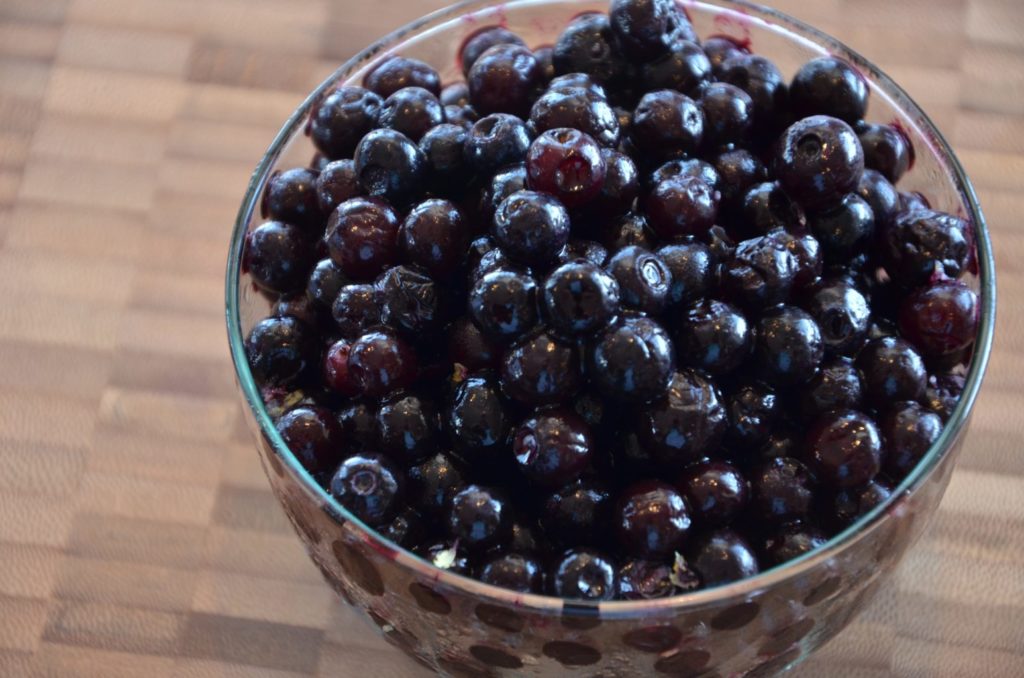Wild Blueberries are powerful with high levels of manganese, vitamin K, and fiber. Wild Blueberries also have one of the highest levels of antioxidants including anthocyanin. The word anthocyanin comes from the words anthos (flower) and kuanos (blue) and it gives fruits like Wild Blueberries, blackberries, eggplants, and cabbage the beautiful blue-purple hues that they hold. Besides the attractive aesthetics, anthocyanin is a powerful antioxidant that has proven health benefits.

What are anthocyanins?
Often found in roots, stems, and especially the plant leaves, anthocyanins are found in two forms. When a sugar is attached to the molecule, it is call anthocyanin however without the sugar molecule, it is called anthocyanidin5. There are three large classifications of anthocyanins that are grouped by their health benefits and how the antioxidant is metabolized and absorbed. In a study by Dr. Jim Fang at the University of Saskatchewan, he largely classified anthocyanins into one of three categories: pelagonidin, cyaniding/peonidin, or multiple anthocyanins group. In general, anthocyanin has been known to protect the plant from stressors like UV light, cold temperatures, and drought6. It is no wonder that antioxidants like anthocyanins are so powerful.
What do antioxidants do?
Antioxidants simply play a game of cops and robbers where the antioxidants are cops and the free radicals are robbers. Every day, the presence of cops (antioxidants) can keep the robbers (radicals) at bay to ensure peace in the city (your body). The more antioxidants you consume, the more protection your body will have from the free radicals that can cause the daily havoc to our bodies. In fact, there are multiple systematic research studies that associate high levels of anthocyanin consumption to lower incidences (new cases) of cardiovascular disease, diabetes mellitus, and cancer. However, more research is needed to determine the recommended daily dose for anthocyanins.
And while consumers are increasingly aware of antioxidants like anthocyanins, the Produce for Better Health Foundation revealed in 2012 that only 3% of fruits and vegetables consumed were purple or blue5. Being familiar with some foods that are high in antioxidants can help us get the most nutritional bang with every bite. Antioxidant level in foods is measured by an Oxygen Radical Absorption Capacity (ORAC) test. Elderberries lead the way, followed by Wild Blueberries, high bush blueberries, red cabbage, and purple carrots, which round out the top five anthocyanin-rich foods5.

What does research say about anthocyanins?
Cognitive Function. Whether you are age 5 or 95, research has shown that anthocyanins can improve cognitive function like memory and day-to-day mental functions. In a study conducted in the UK, Professor Claire Williams and her research team found children performed cognitive tasks better after consuming a Wild Blueberry drink than when they did not1. Similar findings have been presented to show the positive effects of anthocyanin consumption on the working memory of older adults3. Researchers suggest that anthocyanins have the potential to decrease inflammation therefore improving blood flow and increasing communication between cells in the brain7. Anthocyanin-rich foods categorized in the cyanidin and peonidin groups have a greater effect on decreasing inflammation.
Natural anti-inflammatory. Inflammation is a silent killer. Low-grade inflammation is one of the primary mechanisms that attribute to many chronic diseases like obesity and hypertension. While the inflammatory mechanism is complex and involves various components on the cellular level, research has shown that foods like berries, especially bilberries and Wild Blueberries, have anti-inflammatory effects. Inflammation is often exacerbated by diets that are high in fat. A study in Finland examined the effect of anti-inflammatory foods like bilberries and Wild Blueberries in rats while consuming a high fat diet2. The results showed that a high-fat diet combined with whole berries had a lower inflammatory response compared to rats consuming only a high-fat diet. In addition to anti-inflammatory effects, anthocyanin-rich foods have shown to increase insulin sensitivity.
Anti-diabetic. In a study examining the three different groups of anthocyanins the results showed that blueberries are able to induce insulin secretion4. Type 2 diabetics often experience insulin insensitivity and a lower level of insulin is secreted with the consumption of glucose compared to non-diabetics. Consuming Wild Blueberries and red cabbage can be a part of the dietary recommendations to prevent and to manage diabetes, if not heart disease.
Happy Heart. In the United States, 90% of women possess at least one risk factor for heart disease. As one of the leading causes of death in women, it is beneficial for us to integrate preventive measures to curb the problem. In the Nurse’s Health Study I and II as well as the Women’s Health Study, researchers found that those who consumed the most anthocyanin-rich foods can reduce their risk for developing hypertension, coronary heart disease, and cardiovascular disease by 8% to 12%3. Examining the research subject’s intake, researchers found that these individuals consume anthocyanins mainly from blueberries and strawberries. The findings suggest that anthocyanins can decrease the stiffness of the arteries and therefore lower blood pressure and reduce the damage to blood vessels and heart, ultimately reducing the risk of heart disease.
There are many benefits to consuming a diet high in antioxidants. Instead of focusing on diets that are only anti-inflammatory, anti-aging, or anti-diabetic, we recommend increasing a diet high in anthocyanins. Not only will it add a beautiful color to your plate and turn your tongue to a pretty purple-blue color, it will provide a range of health benefits to help manage and prevent conditions and diseases like cognitive decline, inflammation, diabetes, and heart disease.

Resources
- http://www.telegraph.co.uk/food-and-drink/news/blueberry-juice-boosts-brainpower/
- Mykkänen, O. T., Huotari, A., Herzig, K. H., Dunlop, T. W., Mykkänen, H., & Kirjavainen, P. V. (2014). Wild blueberries (Vaccinium myrtillus) alleviate inflammation and hypertension associated with developing obesity in mice fed with a high-fat diet.PloS one, 9(12), e114790.
- Norberto, S., Silva, S., Meireles, M., Faria, A., Pintado, M., & Calhau, C. (2013). Blueberry anthocyanins in health promotion: A metabolic overview.Journal of Functional Foods, 5(4), 1518-1528.
- Fang, J. (2015). Classification of fruits based on anthocyanin types and relevance to their health effects.Nutrition, 31(11), 1301-1306.
- http://www.todaysdietitian.com/newarchives/030314p20.shtml
- http://www.todaysdietitian.com/newarchives/0716p18.shtml
- Thompson K, Pederick W, Santhakumar AB. Anthocyanins in obesity-associated thrombogenesis: a review of the potential mechanism of action. Food Funct. 2016;7(5):2169-2178.


